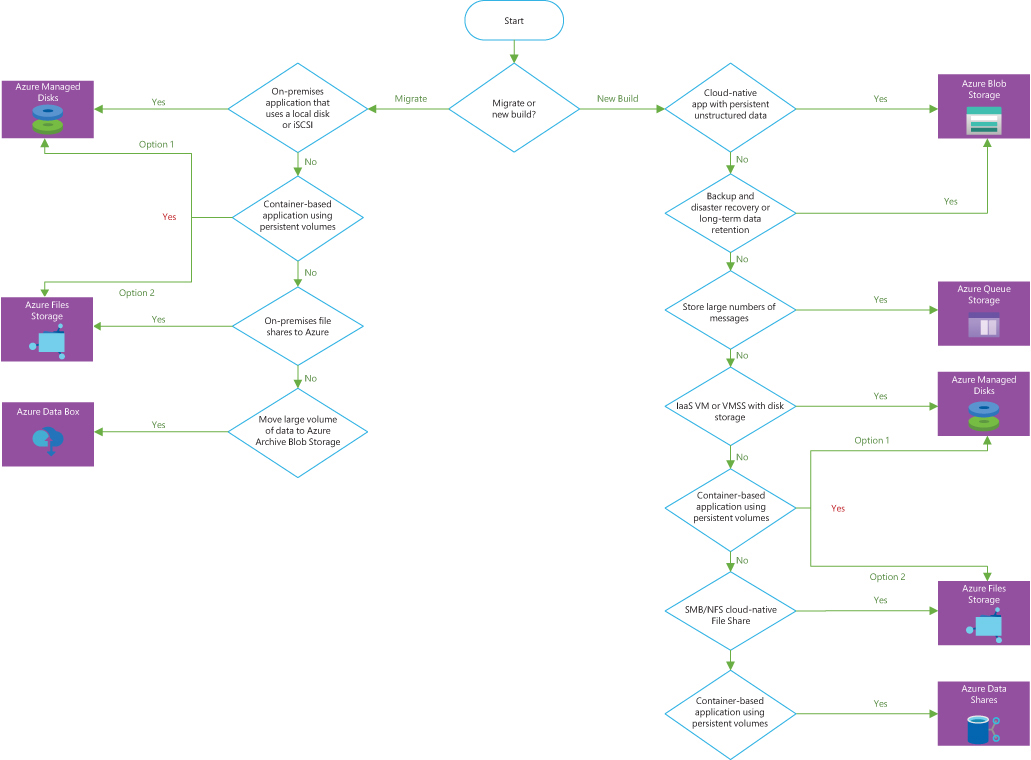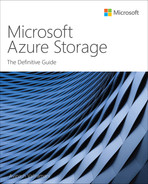Introduction to Microsoft Azure Storage
Welcome to Microsoft Azure Storage: The Definitive Guide. This book includes in-depth information about the various Azure services that provide storage capabilities and shares best practices based on real-life experiences with these services in different environments.
This book focuses primarily on Azure storage services generally available during 2022, encompassing development work done on these services over the years. A few storage features and functionalities were under preview at the time of this writing and could change before they are widely available; thus, we will cover the most notable ones in subsequent iterations of this book as they go live globally.
Overview
Over the years, Microsoft has introduced services related to the Azure storage stack to address various types of application and infrastructure requirements. Microsoft has released regular updates to these services, introducing additional features and functionality, enhancing each service’s support matrix, and making these services easier to deploy and manage with each iteration.
Following is a brief timeline of the announcement of each of these services in public preview or general availability:
Azure Blob Storage February 2010
Azure Queue Storage February 2010
Azure Files September 2015
Azure Managed Disks February 2017
Azure Data Box September 2017
Azure Data Share July 2019
Each service provides customers with different options and features to address their storage requirements. This book dives into each of these services to highlight important considerations in deploying and managing them and to share associated best practices.
Each chapter focuses first on the features provided by a service. The chapter then explores in-depth the concepts behind that service and the components that comprise it so you will understand how that service can deliver value in your Azure deployment. Finally, each chapter focuses on deployment considerations and strategies where necessary, with step-by-step walkthroughs to illustrate deployment and management methods, followed by some best practices.
Cloud service categories
As in earlier books in this series, let’s start by first discussing the different types of cloud service categories. Currently, cloud services are broken down into four main categories: infrastructure as a service (IaaS), platform as a service (PaaS), function as a service (FaaS), and software as a service (SaaS). SaaS is not relevant to the content covered in this Microsoft Azure book series; thus, we will focus on better understanding the first three categories:
Infrastructure as a service (IaaS) Using virtual machines (VMs) with storage and networking is generally referred to as infrastructure as a service (IaaS). This is a traditional approach to using cloud services in line with on-premises workloads. Most on-premises environments use virtualization technologies such as Hyper-V to virtualize Windows and Linux workloads. Migrating to IaaS from such an environment is much easier than migrating to PaaS or FaaS. Over time, as an organization’s understanding of various other types of cloud services grows, it can migrate to PaaS or FaaS.
Platform as a service (PaaS) One of the biggest benefits of using a cloud service is the capability to offload the management of back-end infrastructure to a service provider. This model is called platform as a service (PaaS). Examples of back-end infrastructure include different layers of the application, such as the compute layer, storage layer, networking layer, security layer, and monitoring layer. Organizations can use PaaS to free up their IT staff to focus on higher-level tasks and core organizational needs instead of on routine infrastructure monitoring, upgrade, and maintenance activities. Azure Storage Service and Azure Data Share are examples of Azure PaaS offerings.
Function as a service (FaaS) Function as a service (FaaS) offerings go one step beyond PaaS to enable organizations to focus only on their application code, leaving the entire back-end infrastructure deployment and management to the cloud service provider. This provides developers with a great way to deploy their code without worrying about the back-end infrastructure deployment, scaling, and management. It also enables the use of microservices architectures for applications. An example of an Azure FaaS offering is Azure Functions. There are no such examples for storage services.
In the Azure storage stack, some services fall under the PaaS category, including the following:
Azure Queue Storage This PaaS service enables you to store large numbers of messages in a queue that can be ingested and processed by various application workloads.
Azure File Share This PaaS service allows you to configure and manage SMB/NFS file shares in the Azure cloud platform and access them from Azure or on-premises environments.
Each cloud-service category has various features and limitations. Limitations might relate to the application, technological know-how, costs for redevelopment, among others. As a result, most organizations use some combination of different types of these cloud services to maximize their cloud investments.
Each service provides a different level of control and ease of management. For example:
IaaS provides maximum control and flexibility in migration and use.
FaaS provides maximum automation for workload deployment, management, and use.
PaaS provides a mix of both at varying levels, depending on the PaaS service used.
Each service also offers varying levels of scalability or redundancy. For example:
IaaS might require the use of additional services to achieve true geographical redundancy—for example, using Azure Site Recovery services, a PaaS service, to replicate Azure VMs and the underlying Azure managed disks across multiple Azure regions for redundancy and disaster recovery.
PaaS and FaaS services are generally designed with built-in scalability and load-balancing features—for example, Azure Blob Storage with GRS redundancy level automatically replicates data to another Azure region.
Cost-wise, each service provides varying levels of efficiency. For example:
FaaS offerings charge for compute based only on the usage hours for compute services, making them extremely cost-effective.
IaaS offerings charge for compute services regardless of usage once the compute service (for example, a VM) is online.
PaaS offerings are a mixed bag depending on how the services are configured. Some PaaS products charge for storage resources regardless of usage, while others, if configured correctly, charge based on usage alone. For example:
Azure standard file shares are charged based on the storage used to store the data in the primary region and secondary region, if configured for GRS.
Azure premium file shares are charged based on the storage allocated to store the data in the primary region and secondary region, if configured for GRS, regardless of the storage used.
Migration factors and strategies
Along with these features and limitations, there are certain migration factors to consider when deciding which category of cloud storage service might be the best solution in an organization’s cloud journey. (See Figure I-1.) Of course, organizations can always start with one type of storage service and migrate to another type of storage service over time as their understanding of the cloud matures.

FIGURE I-1 Cloud-migration considerations.
Let’s examine the flow chart shown in Figure I-1 in more detail:
Lift-and-shift migration strategy In a lift-and-shift migration, the organization migrates its existing on-premises environment as-is to the cloud, without redeveloping or redesigning the application stack. A lift-and-shift migration strategy generally involves less effort because no code changes are necessary. Application components remain as-is and are migrated in their current state to the cloud. This is a preferred migration approach for organizations in which:
A hardware refresh or procurement is planned.
Scaling or security limitations require the organization to migrate to the cloud as quickly as possible, with the least amount of disruption.
The organization wants to use IaaS mainly to host its application and database workloads.
Cloud-optimized strategy With cloud-optimized migrations, the organization redesigns or recodes its application as necessary to use PaaS-based storage services. This enables the organization to use microservice architectures, allowing it to truly benefit from the scalability and cost benefits that a cloud service like Azure provides.
Organizations can use a lift-and-shift migration strategy, a cloud-optimized migration strategy, or a combination of the two. For example, an organization might use the flexibility provided by the Azure Managed Disks service to quickly migrate their existing on-premises VMs to Azure using a lift-and-shift approach to quickly benefit from the scaling and global availability of Azure. Then, over time, the organization could migrate to more cloud-optimized PaaS services, such as the Azure File Shares or Azure Blob Storage service, to meet those same needs.
Who is this book for?
Azure Storage: The Definitive Guide is for anyone interested in Azure infrastructure solutions—IT and cloud administrators, network professionals, security professionals, developers, and engineers. It is designed to be useful for the entire spectrum of Azure users. Whether you have basic experience using Azure or other on-premises or cloud virtualization technologies, or you are an expert, you will still derive value from this book. Azure Storage: The Definitive Guide provides introductory, intermediate, and advanced coverage of each widely used storage service.
The book especially targets those who are working in medium to large enterprise organizations; have at least basic experience in administering, deploying, and managing Azure infrastructure or other virtualization technologies such as Microsoft Hyper-V; and want to enhance their understanding of how to build resiliency and redundancy in their on-premises and cloud environments and to leverage the wide range of infrastructure services provided by Microsoft Azure.
How is this book organized?
This book is organized into six chapters:
Each chapter focuses on a specific Azure storage service, covering its inner workings in depth, with walkthroughs to guide you in building and testing the service and real-world best practices to help you maximize your Azure investments.
The approach adopted for the book is a unique mix of didactic, narrative, and experiential instruction:
The didactic component covers the core introductions to the services.
The narrative leverages what you already understand and acts as a bridge to introduce concepts.
The experiential instruction takes into account real-world experiences and challenges in small and large environments and the factors to consider while designing and implementing workloads. Step-by-step walkthroughs on how to configure each Azure monitoring and management service and its related features and options enable you to take advantage of all the benefits each service has to offer.
System requirements
To get the most out of this book, your system must meet the following requirements:
An Azure subscription Microsoft provides a 30-day USD200 trial subscription that can be used to explore most services covered in this book. Some services, such as dedicated hosts, cannot be created using the trial subscription, however. To test and validate these services, you will need a paid subscription. If you plan to deploy any of these restricted services, you will need to procure a paid subscription.
Windows 10/11 This should include the latest updates from Microsoft Update Service.
Azure PowerShell For more information, see https://docs.microsoft.com/en-us/powershell/azure/install-az-ps.
Azure CLI For more information, see https://docs.microsoft.com/en-us/cli/azure/install-azure-cli.
Display monitor This must be capable of 1024 x 768 resolution.
Pointing device You need a Microsoft mouse or compatible pointing device.
About the companion content
The companion content for this book can be downloaded from one of the following pages:
https://MicrosoftPressStore.com/StorageTDG/downloads
https://github.com/avinashvaliramani/AzureStorageTDG
The companion content includes the following:
PowerShell code for each walkthrough in the book (where applicable)
CLI code for each walkthrough in the book (where applicable)
Errata, updates, & book support
We’ve made every effort to ensure the accuracy of this book and its companion content. You can access updates to this book—in the form of a list of submitted errata and their related corrections—at:
MicrosoftPressStore.com/StorageTDG/errata
If you discover an error that is not already listed, please submit it to us at the same page.
For additional book support and information, please visit MicrosoftPressStore.com/Support.
Please note that product support for Microsoft software and hardware is not offered through the previous addresses. For help with Microsoft software or hardware, go to http://support.microsoft.com.
Stay in touch
Let’s keep the conversation going! We’re on Twitter: http://twitter.com/MicrosoftPress.
